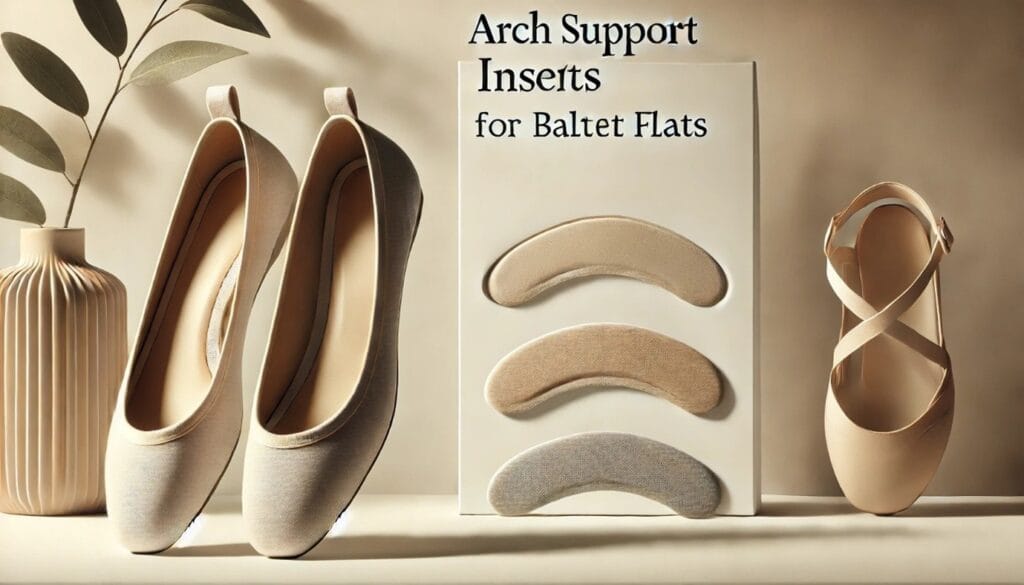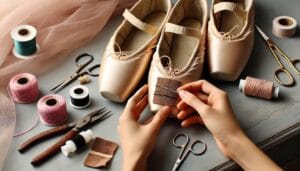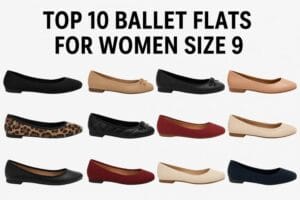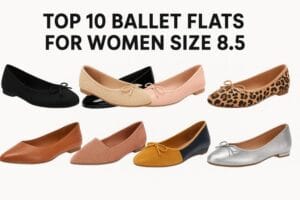How to Add Arch Support Inserts to Ballet Flats? (10 Questions Answered)
- Published on -
- By - Sophia Webster
- Reviewed by - Tory Burch
- Reading Time - 12 Minutes

Share this Post
Recent Posts
About Author
Sophia Webster
Q1. How to Add Arch Support Inserts to Ballet Flats?
While stylish and comfortable, ballet flats have very little arch support. By adding arch support inserts, your flats can be transformed to enable all day wear. For those looking for more guidance, here is a short but detailed guide with useful suggestions to help you modify your beautiful flats.
1. Choose the Right Insert
• Solution: Select arch support inserts specifically formulated for flat shoes. Purchase from brands offering contoured designs supporting your arch.
• Tip: Read product specifications and reviews to confirm the insert accommodates the low profile design of ballet flats.
2. Prepare Your Flats
• Solution: Take out any insoles, if provided because the arch support will facilitate better positioning. This will help increase the space available for the new insert.
• Tip: Prior to placement, ensure you clean the inside of your flats to maintain cleanliness and increase adhesion effectiveness.
3. Trim and Customize
• Solution: Many arch supports can be customized by cutting them to fit. Place the insert into your shoe in the correct position and make sure to outline the area that needs to be trimmed.
• Tip: For the best results, sharp scissors should be used and cuts should be made gradually to prevent removing too much material.
4. Insert and Adjust
• Solution: After trimming, insert the support back into the shoe while ensuring that it sits on the arch of your foot. Walk around the house to see if the support is adequately fitting and comfortable.
• Tip: In case of discomfort, move the insert to a different position, or cut it a little more. Adjusting the position multiple times may be necessary before arriving at the desired outcome.
Q2. Why Do Ballet Flats Lack Arch Support, And How does it Affect Foot Health?

Ballet flats hold an undisputed place on fashion lists due to their sleek elegance and comfort, but their trademark slim outline causes serious concerns with arch support. Here is why ballet flats tend to neglect arch support, the reasons why that deficiency can prove harmful to foot health, and actionable changes that can help alleviate some foot pain.
1. Design Over Function
• Why They Lack Support: Ballet flats come with a bow and a streamlined profile that prioritizes style and comfort over support. The sole and insoles are thin and flexible and do not include any form of built in arch support.
• Tip: To achieve the balance between style and comfort, try using discreet orthotic devices made for ballet flats. These are specifically designed to be unseen while providing subtle support.
2. Impact on Foot Health
• Consequences: A deficiency of arch support can result in excessive inward rolling (overpronation). The rolling causes the plantar fascia to stretch which can lead to foot pain or flat feet. Could also lead to long term knee or back discomfort.
• Solution: Make it a habit to include exercises that strengthen arches to maintain foot health. In addition, regularly changing shoes and avoiding long periods in unsupportive footwear can help alleviate discomfort.
3. Solutions for Lovers of Ballet Flats
• Customized Arch Support: There is a discreet arch support option for ballet flats that comes as a wide customization insert.
• Proper Fitting: Put on your ballet flats and check if your shoes have the proper fitting. Consider squeezing in a slightly elevated footbed contour to the shoe since it can help with reduction of foot movement.
• Footwear Change: If you are a person who has to wear ballet shoes for most of your day but struggles with foot soreness, then plan ahead of time to include supportive shoes for your feet to avoid exacerbating any chronic issues.
Q3. What Types of Arch Support Inserts Work Best for Ballet Flats?

Though beautiful, ballet flats can be challenging for individuals who require additional arch support. The right insert can be both ergonomic and aesthetic. Here’s a quick guide that will assist you with your selection:
1. Thin Arch Inserts
• Solution: Thin arch supports are crafted to fit seamlessly into your ballet flats, so you don’t have to worry about them disrupting the original shape of the shoe.
• Tip: Stick to the plan of thin arch supports if you intend to have an increase in comfort with no increase in bulk. For the strongest effect, they should be limited to daily use while maintaining the original design of the shoes.
2. Custom Inserts
• Solution: Custom inserts are made to suit the exact specifications of your feet’s shape and arch type which leads to enhanced comfort.
• Tip: Consider getting custom-made inserts if you have specific chronic foot problems or specific foot requirements. While they may initially appear more expensive, the optimal support coupled with their enduring quality makes them cost-effective over time.
Q4. How Do I Choose the Right Size of Inserts Without Making My Flats Too Tight or Uncomfortable?
1. Know the interior space of your shoe.
• Solution: Knowing the space in your flats begins with taking out any old inserts. Measure the length, depth, and width of the inside.
• Tip: To avoid crowding the toe box, make certain that the new insert is not too big by using a piece of paper or flexible ruler to trace the shape.
2. Accurate Foot Measurement
• Solution: Since the feet may differ in size, measure both of them. You can use a piece of tape or even a pencil to trace the outline of the foot to figure out the size of the insert.
• Tip: Measure in the evening when the feet are naturally a bit wider so the insert will not feel snug if worn for long periods.
3. Selecting Suitable Thickness
• Solution: With the various thickness options, choose the one that best fits your needs. If your flats are somewhat snug, go with a flat and thinner insert.
• Tip: If samples are available try them out, otherwise look for reviews concerning comfort level. Excellent options for custom comfort include removable layers of adjustable thickness.
4. Final Step And Comfort
• Solution: Try the insert with your flats on prior to wearing them outside to see the feel. This allows you to determine potential irritation from the insert before put in the shoes.
• Tip: Seek out trim-to-fit-shaped inserts. Small changes can make a big impact towards assuring there is no discomfort while still keeping the shoe secure.
Q5. Can arch support inserts be trimmed or customized for ballet flats?
Ballet flats are elegant and multifunctional, but they often lack the necessary arch support for sustained comfort throughout the day. Many arch support inserts can be trimmed specifically to suit your flats. Here’s a brief, yet detailed guide to assist you in achieving a perfect fit.
1. Trimmable Inserts: Yes, They Can!
• Solution: Numerous high-quality arch support inserts feature pre-scored trim lines designed to contour to the shape of your ballet flats easily.
• Tip: Trim a fraction of the material first to test. It is easier to remove than to put it back.
2. Choose the Right Type for Flats
• Solution: Search for flexible and thin inserts that won’t add bulk to your delicate ballet flats.
• Tip: Choose ultra-thin options made of memory foam or gel. These materials provide good support while maintaining the elegant shape of the shoes.
3. Customization Techniques
• Solution: Use sharp scissors to customize the insert to fit the shoe by rounding and trimming the edges. A little tapering will help avoid too much cutting.
• Tip: Use a pencil to outline the shape and mark the insert before cutting. This will provide a helpful guide to ensure that both shoes are cut symmetrically.
4. Final Fitting and Adjustment
• Solution: After trimming, put on your flats and walk around the house to check for comfort and the need for any further adjustments. Make any other small changes as you see fit.
• Tip: If you think you need help with the fit, consult a shoe specialist. They will help to adjust the insert in the best way possible to ensure it suits your needs.
Q6. How do I properly place the arch support insert inside the flat for maximum comfort?
1. Prepare Your Flat
• Solution: Take out any insoles already in the flats and give them a quick wash.
• Tip: The insert will stick better to a clean and empty space as there will be less friction.
2. Identify Your Arch
• Solution: From a standing position, attempt to identify the arch of your foot by looking at the area that forms an inward curve.
• Tip: Lightly outline that area with a washable marker or place your finger there to create a visible indication to ensure accuracy.
3. Align the Insert with Precision
• Solution: The foot insert should be placed in a way that its scroll-shaped edge rests over the arch of the foot.
• Tip: Ask someone or look in a mirror to visualize the insert and confirm it is over the middle of the arch. If it does not feel comfortable, move it until it feels like a natural fit.
4. Trim for a Custom Fit
• Solution: Use scissors to cut off the parts of the insert that go beyond the limits of the flats.
• Tip: Always trim bit by bit; there’s a possibility to remove additional material if needed, but it is literally impossible to reattach once cut!
5. Test and Adjust
• Solution: Walk around the house while wearing the flats for a short period to assess comfort and support.
• Note: If any discomfort is experienced, It is advised that the insert be repositioned or trimmed further before stepping out.
Q7. Will adding inserts change the fit or appearance of my ballet flats?
Ballet flats are recognized for their understated beauty and ease. A lot of people question the effect of the addition of inserts. With the right method, you may adjust your comfort without losing style. Adding style does not mean losing comfort and that is what this guide packed with practical solutions and tips offers.
1. Impact on Fit
• Solution: They can lose out on comfort enabling inserts making the shoes feel more snug. To retain the initial fit, choose an insert that is thin and low profile made specifically for flats.
• Tip: If you are planning on actually making a purchase, do it for the trial insert set. It will help determine if your shape floods the shoe and not the other way around when it comes to cushioning.
2. Preserving the Aesthetic
• Solution: Many modern ballet flats are tailored to be as discreet as possible, so the sleek look of your shoes is preserved. Look for designs tagged “ultra-thin” or “invisible” that are crafted to retain the original appearance.
• Tip: Check how other customers have reviewed these products and try seeing how other users have adapted these inserts into their ballet flats. Seeing these can help a lot when trying to find an insert that works well with your shoes.
3. Choosing the Right Type
• Solution: There are many types of gel, foam, memory foam, and cushioned footbeds. Each offers unique benefits: shock absorption comes with gel, while memory foam conforms to the shape of your foot and provides comfort.
• Tip: Think about what needs are most important to you. If you’re after increased arch without extra bulk, a thin gel insert might be your best bet. If a softer feel is prioritized, then thin layers of memory foam can be more ideal.
4. Fine-Tunning the Fit
• Solution: Sometimes a small tweak can lead to a profound improvement. If the insert does change the fit ever so slightly, a professional shoe fitter might be able to help modify the insole or suggest other inserts that are less likely to cause fitting issues.
• Use Tip: Wear your new inserts for brief intervals to give your feet time to adjust and ensure comfort in the long run.
Q8. Are there removable inserts that stay in place and don’t slip during wear?
1. Use non-slip-backed materials as a top priority
• Solution: Search for inserts with textured silicone or rubber backings that grip and adhere securely to the inside of the shoe.
• Tip: If possible, take a sample of the insert and place it on the shoe’s insole; if it can be wiggled around slightly, then the insert will remain.
2. Selecting the right shape and fit
• Solution: Select inserts with contour designs that fit the dimensions of your foot. A well-fitting insert minimizes movement that could cause it to shift and ensures that it sits flush with the shoe.
• Tip: Look for inserts that can be trimmed as this will allow for customization and precision to achieve exact requirements.
3. Consider featured adhesive strips positioned on the border of the insert as an interior securing method
• Hint: Consider using specialized double-sided shoe tape for your favorite insert if it doesn’t come with adhesive for better hold and stability while protecting your shoes.
4. Look for Reviews
• Solution: Check for inserts made by well-known brands that are famous for quality and durability because brand reputation significantly influences the reviews users leave about the product’s reliability to stay in position for a long duration.
• Tip: It is okay to go out of budget on some of the non-slip inserts because they are proven to have non-slip features as these non-slip inserts are more likely to be comfortable in the long run.
Q9. Should I choose adhesive inserts or non-adhesive ones for flexibility and longevity?
Adhesive Inserts: Stability at a Stick
• Solution: If your activities for the day are high energy, consider using adhesive inserts as they require durability since these will stick firmly to the insole.
• Tip: Use good quality adhesive that can withstand multiple pulls along with leave residue, but does not leave residue for a long time.
Non-Adhesive Inserts: Flexibility and Customization
• Solution: Hinged non-adhesive inserts do not require clips and attach by the means of shape and friction. They can be put at the desired location, making them easy to remove.
• Advice: Search for pads that have contour grips or have silicone backing; this will enhance stability while still making the inserts removable.
The Ballet Slippers Dance: The Balance Between Flexibility and Longevity
• Solution: If you’re looking for something more adaptable and durable, try hybrid designs with areas of light adhesive and non-adhesive sections.
• Tip: Whichever type of insert you choose, make sure to regularly clean and examine them to maintain performance.
Q10. How often should I replace arch support inserts in ballet flats?
Ballet slippers are a fashion statement suggesting class and dainty traditions, but their supportive nature tends to dwindle over time. Ideally timed replacements of the arch support inserts can work miracles. Solutions listed herein are strategically bound to keep your feet feeling elated and well-supported.
1. Track and Record Wear and Tear
• Solution: Set aside some time and check your pads and utensils for signs of compression, flattening, or any other form of wear and tear.
• Tip: Loss of shape and support from the cushioning means it’s time to let it go.
2. Frequency Based on Usage
• Solution: If using arch supports on a daily basis, replace them every 6 to 12 months. With occasional use, they should last longer.
• Tip: Keeping a simple reminder or log in your calendar would help check these inserts at a minimum of twice a year.
3. Listen to Your Feet
• Solution: If you begin feeling discomfort or pain or decline in support, your inserts have very likely reached the end of their useful life.
• Tip: There is no need to suffer some major problem—addressing signs of wear and tear enables prevention of chronic foot issues.
Conclusion:
Attaching arch support inserts to ballet flats is a simple yet significant modification that can increase comfort and protect foot health, particularly because most ballet flats lack built-in support.
This absence increases the risk for foot fatigue, pain, and various long-term issues, and makes using inserts a wise decision. When selecting inserts, the best options are thin, low-profile gel, foam, or custom orthotics to avoid surges in bulk within the shoe. It is also important to use the correct size, and those that can be trimmed to size are ideal to maintain comfort.
The insert must be positioned such that it fits securely right beneath the arch without moving. As previously noted, selecting an insert will change the fit of the shoe and may also change the style. However, selecting a design that has a lower profile will ensure that it will not alter the look of the flats. Depending on your needs, removable inserts with gentle adhesive or non-slip support can offer stability or flexibility.






